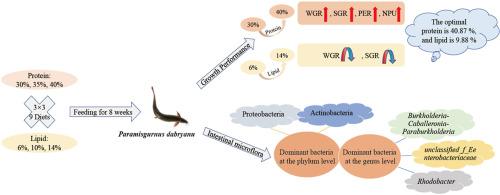Animal Nutrition ( IF 6.3 ) Pub Date : 2023-03-02 , DOI: 10.1016/j.aninu.2023.02.007 Zirui Wang 1, 2 , Shuyao Li 1, 2 , Qiubai Zhou 1, 2 , Jinhua Zhang 1, 2 , Yongan Li 1, 2 , Youjie Li 1, 2 , Zhiwen Yuan 1, 2 , Guanghua Huang 1, 2

|
The aim of this study was to examine the effects of dietary protein and lipid levels on the growth performance and homeostasis of the intestinal flora in Paramisgurnus dabryanus. An 8-wk 3 × 3 two-factorial experiment was conducted to investigate the interaction between dietary crude protein (CP: 30%, 35%, 40%) and ether extract (EE: 6%, 10%, 14%) on the growth rate and the intestinal microflora of P. dabryanus. A total of 2,160 fish (5.19 ± 0.01 g) were randomly allotted to 36 aquariums each with 60 fish. Fish were fed the experimental diet twice daily. Results revealed that weight gain rate (WGR), specific growth rate (SGR), protein efficiency ratio and net protein utilization significantly increased when increasing protein levels from 30% to 40% (P < 0.05). Both WGR and SGR enhanced first but reduced thereafter with maximum value at 10% lipid level as dietary lipid increased from 6% to 14% (P < 0.05). Significant interactions between protein and lipid were found with feed conversion rate, lipid efficiency ratio and net lipid utilization (P < 0.05). At the phylum level, Proteobacteria and Actinobacteria were the dominant bacteria; at the genus level, Burkholderia-Caballeronia-Paraburkholderia was the dominant bacteria. Fish fed the diet containing 10% lipid had a higher abundance of Proteobacteria and unclassified_f_Eenterobacteriaceae than those fed the 14% lipid diet, and a higher abundance of Rhodobacter than those fed the 6% lipid diet (P < 0.05). Analysis of the predicted functions showed that metabolism in the intestine of fish in the CP40EE10 group was more active than that in CP30EE14 group. Polynomial regression analysis found that a diet containing 40.87% protein and 9.88% lipid can be considered optimal for P. dabryanus.
中文翻译:

不同蛋白质和脂质水平对泥鳅(Paramisgurnus dabryanus)生长性能和肠道菌群的影响
本研究的目的是研究日粮蛋白质和脂质水平对达氏副鲈生长性能和肠道菌群稳态的影响。进行了一项为期 8 周的 3 × 3 双因素实验,以研究膳食粗蛋白(CP:30%、35%、40%)和乙醚提取物(EE:6%、10%、14%)之间的相互作用。P. dabryanus的生长速度和肠道菌群。总共 2,160 条鱼 (5.19 ± 0.01 g) 被随机分配到 36 个水族馆,每个水族馆有 60 条鱼。每天两次向鱼喂食实验饮食。结果显示,当蛋白质水平从 30% 增加到 40% 时,增重率 (WGR)、比生长率 (SGR)、蛋白质效率比和净蛋白质利用率显着增加(P < 0.05)。WGR 和 SGR 均先增加但随后降低,随着膳食脂肪从 6% 增加到 14%,在 10% 脂肪水平时达到最大值(P < 0.05)。饲料转化率、脂肪效率比和脂肪净利用率与蛋白质和脂肪之间存在显着交互作用(P < 0.05)。在门水平上,变形菌和放线菌是优势细菌;在属水平上,Burkholderia-Caballeronia-Paraburkholderia是优势菌。喂食含有 10% 脂肪的饲料的鱼比喂食 14% 脂肪饲料的鱼有更高丰度的变形杆菌和unclassified_f_Eenterobacteriaceae ,并且比喂食 6% 脂肪饲料的鱼有更高丰度的Rhodobacter (P < 0.05)。预测功能分析表明,CP40EE10组鱼的肠道代谢比CP30EE14组更活跃。多项式回归分析发现,含有 40.87% 蛋白质和 9.88% 脂肪的饮食可以被认为是对达氏龙虾的最佳选择。

























 京公网安备 11010802027423号
京公网安备 11010802027423号